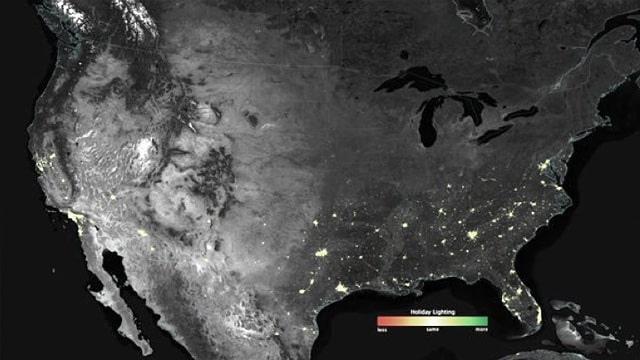Do you ever wonder what the United States looks like from above at night? With so many cars, bustling cities and street lights, our country gives off quite the glow… especially around the holidays.
Most people have probably unplugged their lights from the holiday season by now… and thank goodness, because the holiday season causes a significant spike in the earth’s brightness. According to BBC News, scientists used the Suomi NPP satellite to survey the brightness of the United States around the holidays. They found that brightness jumps 20-50% in most US cities.
While the holiday lights may look pretty from outside the atmosphere, it actually presents a bit of a problem for scientists in our country.
The name of the problem: Light pollution.
What is light pollution?
Light pollution (also called luminous pollution or photopollution) is the excessive misdirection of artificial light into the night sky. It is caused by bright outdoor lighting with improperly shaped lamp shades that misdirect light and create glare. You’ve probably seen light pollution in action before. If you go to a large city on a clear night and look up at the sky, you will be hard-pressed to see many stars. However, if you drive out to the countryside and look up, you are able to see millions of stars perfectly clearly. Light pollution becomes especially prevalent around the holidays, since many people add outdoor lighting to their homes as decorations.
What are the consequences of light pollution?
National Geographic points out that light pollution may interfere with the natural biological cycles of nocturnal species. For example, sea turtles that typically nest on beaches will not come ashore in areas where bright unnatural lighting is present. Light pollution has also been shown to disturb migratory patterns of birds in the United States, as the birds are disoriented by the bright glow of unnatural light. With so many thousands of species depending on the dark of night, light pollution presents a real risk.
Not only are ecosystems at risk as a result of light pollution, but scientists who study the night sky are battling decreasing visibility. Scientists all over the world are searching for ways to spread the word about light pollution in order to preserve endangered night skies. With low visibility, the study of the night sky as well as outer space is inhibited.
How can we put a stop to light pollution?
– Unlike other forms of pollution, the answer to light pollution is simple:
- – Turn down the lights.
- – Turn unneeded lights off.
- – Properly shade lights to reduce glare and direct light more efficiently.
How does seeing the earth from space help us solve the problem of light pollution?
Studying the Earth from above helps people in STEM fields to understand issues such as light pollution. By observing spikes and growth trends in different geographical regions, scientists are able to pinpoint the cause of increased light pollution and spread the word about how to prevent it.
That is why we love weather balloon projects here at StratoStar. By taking students high above the earth and into the edge of space, we can teach them the importance of science, technology, engineering and mathematics. With a weather balloon project from StratoStar, classrooms all over the country are able to see our country from the stratosphere. To learn more about how to start a weather balloon project at your school, contact the team at StratoStar.



